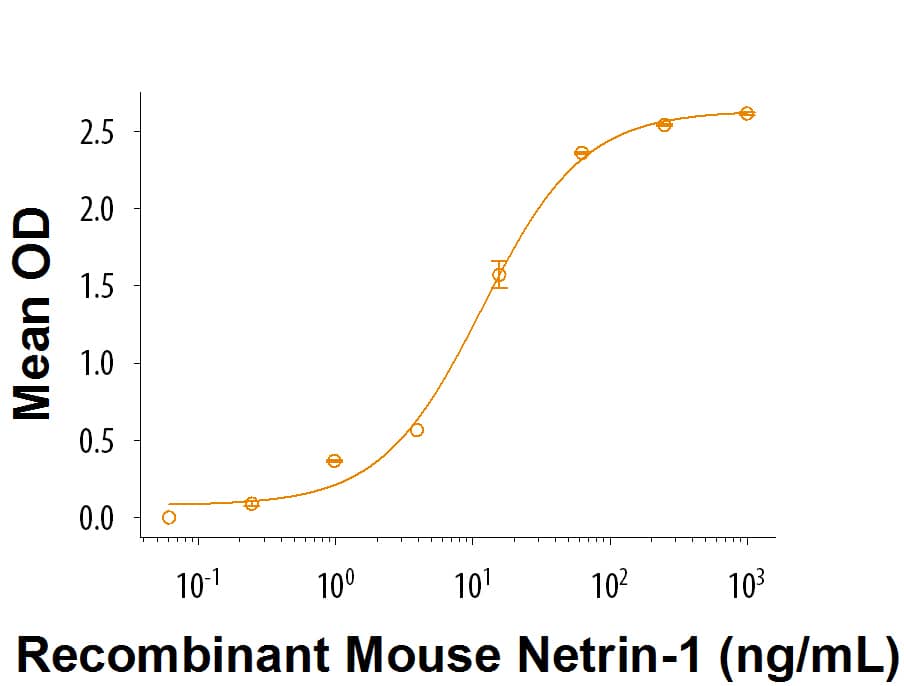Recombinant Human Neogenin Fc Chimera Protein, CF
R&D Systems, part of Bio-Techne | Catalog # 9699-NE

Key Product Details
Source
HEK293
Accession #
Structure / Form
Disulfide-linked homodimer
Conjugate
Unconjugated
Applications
Bioactivity
Product Specifications
Source
Human embryonic kidney cell, HEK293-derived human Neogenin protein
| Human Neogenin (Ala34-Met1104) Accession # Q92859-1 |
IEGRMD | Human IgG1 (Pro100-Lys330) |
| N-terminus | C-terminus |
Purity
>95%, by SDS-PAGE visualized with Silver Staining and quantitative densitometry by Coomassie® Blue Staining.
Endotoxin Level
<0.10 EU per 1 μg of the protein by the LAL method.
N-terminal Sequence Analysis
Ala34
Predicted Molecular Mass
144 kDa
SDS-PAGE
142-164 kDa, reducing conditions
Activity
Measured by its binding ability in a functional ELISA.
When Recombinant Human Neogenin Fc Chimera is coated at 1 μg/mL (100 μL/well), the concentration of Recombinant Mouse Netrin-1 (Catalog # 1109-N1) that produces 50% optimal binding response is 3-15 ng/mL.
When Recombinant Human Neogenin Fc Chimera is coated at 1 μg/mL (100 μL/well), the concentration of Recombinant Mouse Netrin-1 (Catalog # 1109-N1) that produces 50% optimal binding response is 3-15 ng/mL.
Reviewed Applications
Read 1 review rated 5 using 9699-NE in the following applications:
Scientific Data Images for Recombinant Human Neogenin Fc Chimera Protein, CF
Recombinant Human Neogenin Fc Chimera Protein Binding Activity
When Recombinant Human Neogenin Fc Chimera (Catalog # 9699-NE) is coated onto a microplate at 1 µg/mL, Recombinant Mouse Netrin-1 (Catalog # 1109-N1) binds with an ED50 of 3-18 ng/mL.Formulation, Preparation and Storage
9699-NE
| Formulation | Lyophilized from a 0.2 μm filtered solution in PBS with Trehalose. |
| Reconstitution |
Reconstitute at 500 μg/mL in PBS.
|
| Shipping | The product is shipped at ambient temperature. Upon receipt, store it immediately at the temperature recommended below. |
| Stability & Storage | Use a manual defrost freezer and avoid repeated freeze-thaw cycles.
|
Background: Neogenin
References
- Meyerhardt, J.A. et al. (1997) Oncogene 14:1129.
- Keeling, S.L. et al. (1997) Oncogene 15: 691.
- Hagihara, M. et al. (2011) J. Biol. Chem. 286: 5157.
- Tian, C. and J. Liu (2013) Mol. Reprod. Dev. 80:700.
- Severyn, C.J. et al. (2009) Biochem. J. 422:393.
- van den Heuvel, D.M. et al. (2013) PLoS ONE 8:e55828.
- De Vries, M. and H.M. Cooper (2008) J. Neurochem. 106:1483.
- Krauss, R.S. et al. (2005) J. Cell. Sci. 118:2355.
- Srinivasan, K. et al. (2003) Dev. Cell 4:371.
- de Castro, F. (2003) News Physiol. Sci. 18:130.
- O' Leary, C.J. et al. (2015) Stem Cells 33:503.
- Milla, L.A. et al. (2014) Int. J. Cancer 134:21.
- Akino, T. et al. (2014) Cancer Res. 74: 3716.
- Kim, S.J. et al. (2014) Oncotarget 5:3386
Alternate Names
NEO, NEO1, NGN
Gene Symbol
NEO1
UniProt
Additional Neogenin Products
Product Documents for Recombinant Human Neogenin Fc Chimera Protein, CF
Product Specific Notices for Recombinant Human Neogenin Fc Chimera Protein, CF
For research use only
